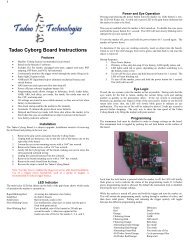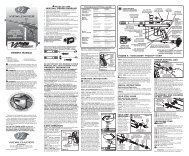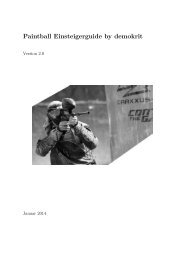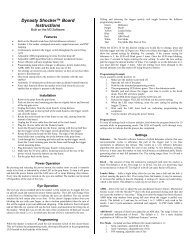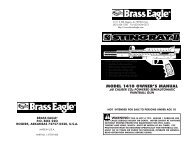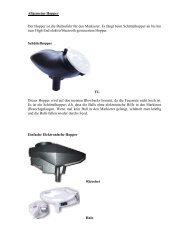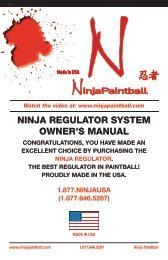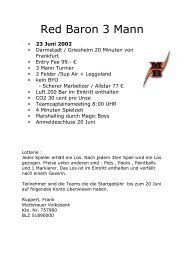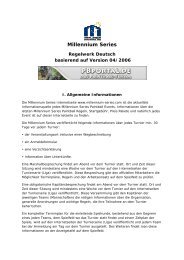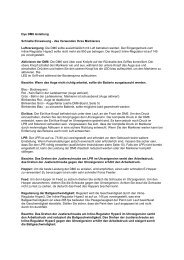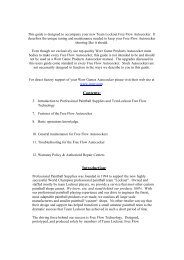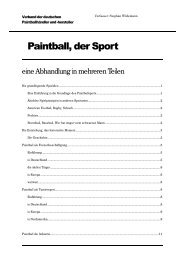STAKO Sp. j - PBportal.de
STAKO Sp. j - PBportal.de
STAKO Sp. j - PBportal.de
You also want an ePaper? Increase the reach of your titles
YUMPU automatically turns print PDFs into web optimized ePapers that Google loves.
Control audit report<br />
TÜV NORD Polska <strong>Sp</strong>. z o.o.<br />
ul. Grunwaldzka 212<br />
80-266 Gdańsk<br />
Tel/fax +48 (58)345 55 06<br />
Tel/fax +48 (58)340 43 48<br />
No. 02/GDA/07<br />
<strong>STAKO</strong> <strong>Sp</strong>. j.<br />
Or<strong>de</strong>rer :<br />
<strong>STAKO</strong> <strong>Sp</strong>.j.<br />
Ul. Poznańska 54<br />
76-200 Słupsk<br />
Or<strong>de</strong>r no.: PH 102/07<br />
Manufacturer:<br />
Appliance:<br />
Goal:<br />
Attachments:<br />
<strong>STAKO</strong> <strong>Sp</strong>.j.<br />
Ul. Poznańska 54<br />
76-200 Słupsk<br />
composite tank for compressed air<br />
with 1.1 L capacity<br />
Execution of a control audit of the manufacturing process and<br />
control procedures for the composite tank for compressed air<br />
with 1.1 L capacity<br />
- cause-effect diagram<br />
- FMEA (Failure Mo<strong>de</strong>s and Effects Analysis)<br />
- schedule of improvement actions for FMEA<br />
- control plan<br />
- quantitative analysis of reported complaints<br />
- complaints reports<br />
- photo of the tank during pressure test with air un<strong>de</strong>r pressure<br />
of 300 bar<br />
- photo of the i<strong>de</strong>ntified <strong>de</strong>fect of complained tank<br />
- photo of cross-section of the place of setting of the aluminium<br />
head into the liner before and after implemented technological<br />
changes<br />
- report from pressure, wear and tear tests<br />
Date: 12-13.06.2007<br />
Contact person:<br />
S.Kubicz<br />
A.Kaszczuk<br />
<strong>STAKO</strong><br />
TÜV Nord Polska
Strona 2 / 4<br />
sprawozdania TÜV Nord Polska <strong>Sp</strong>. z o.o. Nr. <strong>STAKO</strong> 02/DN/07<br />
Control audit report<br />
1. Goal of the audit.<br />
Application correctness assessment of the production and control procedures for manufacturing<br />
of Paintball composite tanks for compressed air with 1.1 L capacity with durability<br />
tests of randomly chosen tanks.<br />
The reason for conducting the control actions was the reported leakage of a tank during the<br />
tournament of Millennium League in Germany on 20.05.2007.<br />
Applying for execution of the control audit is the manufacturer of the tank, <strong>STAKO</strong> <strong>Sp</strong>. j.<br />
based in Słupsk.<br />
2. Introduction.<br />
Composite pressure tanks manufactured using continuous fibre reinforcement technology<br />
are pressure appliances for operation un<strong>de</strong>r high pressure. Safety of the use of this<br />
type of tanks should be assured by following the <strong>de</strong>sign, manufacturing and control procedures,<br />
which are specified by appropriate standards and legal requirements.<br />
Composite tanks for compressed air with 1.1 L capacity, manufactured by <strong>STAKO</strong> <strong>Sp</strong>. j.<br />
from Słupsk, mainly <strong>de</strong>dicated for “Paintball” game, are ma<strong>de</strong> in compliance with the EN<br />
12245 standard and the 1999/36/WE directive.<br />
This tank was introduced to the market in 2005, passed required official certification<br />
tests conducted by TÜV NORD and received certificate No. D-0045-320 which was issued<br />
on 6.12.2004.<br />
The construction safety of this tank was confirmed by a series of durability tests of the<br />
materials used for manufacturing of the tank and by tests conducted within the official certification<br />
process.<br />
The level of previously reported and recognised complaints of tanks in years 2005, 2006<br />
and until June of 2007, caused by leakage, did not exceed the acceptable level of complaints<br />
assumed in the quality control system of <strong>STAKO</strong>.<br />
Until the last complaint report was submitted, no corrective actions in production and<br />
control processes were ma<strong>de</strong>.<br />
To answer the question why, the tank leakage occurred while it was being used, <strong>STAKO</strong><br />
sp. j. or<strong>de</strong>red the certifying unit TÜV NORD to execute a control audit of the tank’s production<br />
and control processes.<br />
3. Audit program.<br />
a. Examination of the production process and associated control procedures,<br />
b. Examination of the complained tank and fault analysis leading to <strong>de</strong>termination of<br />
their root-cause,<br />
c. Evaluation of the validity of modifications implemented into the production process,<br />
d. Examination of the tank from the production batch of 200 tanks – standard procedure,<br />
e. Fatigue examination of the tank – In or<strong>de</strong>r to validate correctness of the <strong>de</strong>sign,<br />
f. Preparation of the final report.
Strona 3 / 4<br />
sprawozdania TÜV Nord Polska <strong>Sp</strong>. z o.o. Nr. <strong>STAKO</strong> 02/DN/07<br />
4. Report of conducted actions.<br />
Inspection of the manufacturing records of 1.1 L composite tanks did not show <strong>de</strong>viations<br />
in the production process. <strong>Sp</strong>ecified control procedures for technological operations<br />
and acceptance procedures for the batch of manufactured tanks were realized in accordance<br />
with the technological process and the requirements of the EN 12245 standard.<br />
Technological instructions for every step of manufacturing were available at workstations<br />
and instructions contained within the control plan were being followed.<br />
Before the inspection visit of the TÜV NORD representative, <strong>STAKO</strong> conducted their<br />
own tank tests, on the basis of which, they conducted FMEA of potential reasons which<br />
may cause leakage formation in tanks.<br />
In or<strong>de</strong>r to conduct the analysis <strong>STAKO</strong> prepared a cause-effect chart, analysing all<br />
process elements resulting from human activity, material or method - the manufacturing<br />
process, the system in which the process is realized, and the appliances participating in the<br />
process.<br />
The chart listed the possible situations affecting the possibility of leakage formation,<br />
then, this chart and schedule of improvement actions were used to prepare the FMEA,<br />
which specified the effect of improvement actions on the quality of the product. The studies<br />
mentioned above were presented to a TÜV NORD representative during the audit and were<br />
enclosed with the audit report.<br />
During the audit, two manufactured tanks and the tank the complaint concerned were<br />
examined.<br />
- From batch 703 of manufactured tanks, tanks with numbers 3669 and 3502 were randomly<br />
chosen.<br />
Tank no. 703/3669 was visually examined, and subsequently a water pressure test with<br />
pressure 450 bar was conducted. After a positive air-tightness test, the tank was put to a fatigue<br />
test with application of variable loads in 5000 cycles in range from 2.5 to 450 bar<br />
(<strong>STAKO</strong> increased the <strong>de</strong>mands of the test raising the upper pressure from 300 to 450 bar).<br />
After the tank passed the test, it was put up for a burst test.<br />
The test was stopped at a pressure of 1150 bar without having the tank burst, in or<strong>de</strong>r to<br />
protect the installation. The required pressure, which a tank should endure, is 900 bar. The<br />
result was regar<strong>de</strong>d as positive.<br />
- The second tank no. 703/3502 was put to the test for torsion of the tanks neck with the<br />
torque with value of 150% those admissible by <strong>STAKO</strong>.<br />
This tank positively passed both the un<strong>de</strong>rwater pressure test and the air tightness test.<br />
Subsequently it was put to a fatigue test with application of variable loads in 1000 cycles in<br />
range from 2.5 to 450 bar.<br />
After the tank passed the test, it was submitted to an air pressure test with pressure 300<br />
bar. Test en<strong>de</strong>d positively, no leakages in the tank were found.<br />
- The tank the complaint concerned 648/2457 was put up for water pressure test with pressure<br />
450 bar, which displayed leakage (explicit leak from the region of the setting of the<br />
aluminium head into the liner). The exact point of the leak was impossible to locate, because<br />
the place from which the leak was emerging was un<strong>de</strong>r carbon fibre wrap, not necessarily<br />
opposite the place of the crack in the liner.<br />
After cutting the tank and removal of the carbon fibre wrap, the location of the crack was not<br />
visible.<br />
In the region of the head’s neck at the point of contact of the liners material and aluminium<br />
element there was local thinning of the plastic layer (photo attached)
Strona 4 / 4<br />
sprawozdania TÜV Nord Polska <strong>Sp</strong>. z o.o. Nr. <strong>STAKO</strong> 02/DN/07<br />
5. Conclusions of the executed audit.<br />
The executed examination of production process, control process and acceptance process<br />
of 1.1 L composite tanks did not display any infringements. All tests verifying the quality<br />
of composite tanks manufactured by <strong>STAKO</strong> <strong>Sp</strong>.j. were passed positively.<br />
During the inspection, no explicit cause of leakage of tanks revealing itself during exploitation<br />
was established. The place, which could be at risk of cracking, because of variable<br />
loads when the tank is being filled or emptied, was the region of the neck of the head at the<br />
point of contact of the liners material and aluminium element.<br />
Because of repeatability of forming the plastic layer in the form, no explicit reason of<br />
inequality in plastic coating at the point of the contact of the liner with the aluminium element<br />
was pointed.<br />
In FMEA <strong>STAKO</strong> presented the factors, which could have a potential effect on formation<br />
of leakages in the tanks.<br />
<strong>STAKO</strong> implemented the recommen<strong>de</strong>d improvement actions listed in FMEA into production<br />
process.<br />
After implementation of changes thermoplastic liners and finished tanks were manufactured,<br />
and <strong>STAKO</strong> conducted production tests on them.<br />
Performed actions did not display differences in the quality of manufactured tanks, because<br />
examination results before and after implementation of changes in the production process<br />
were consistently positive.<br />
Changes of production process suggested in FMEA were introduced by <strong>STAKO</strong> permanently<br />
into the tank manufacturing technology.<br />
As a result of the executed audit TÜV NORD representative stated, that <strong>STAKO</strong> sufficiently<br />
fulfilled the efforts nee<strong>de</strong>d to <strong>de</strong>tect possible reasons which might induce single inci<strong>de</strong>nts<br />
of tank leakage and introduced improvement actions into the production process basing<br />
on FMEA.<br />
Resuming production of mentioned tanks, which was suspen<strong>de</strong>d on 22.05.2007 by<br />
Quality Assurance Team until analysis of the production and control system, construction of<br />
the liner with a set aluminium head element, as well as finished tank, during production period<br />
following introduction of changes in technological process, should be covered with increased<br />
level of control, in or<strong>de</strong>r to <strong>de</strong>termine the effect of changes on the increase of the<br />
tank operation safety.<br />
Because of that, the TÜV NORD representative recommen<strong>de</strong>d, especially in that period:<br />
- introduction of additional changes into the composite tank control plan in operation no 140<br />
pos 79-82, with regard to <strong>de</strong>tection of the liner faults, which could affect the tank operation<br />
safety, with additional control of quality control division,<br />
- introduction of internal endoscope inspection of the point of contact of the liners neck with<br />
the aluminium head element,<br />
- covering the control regarding quality and portioning of plastic for tank production with the<br />
activities of quality control divisions.<br />
Artur Kaszczuk<br />
Appraiser<br />
TÜV NORD POLSKA





